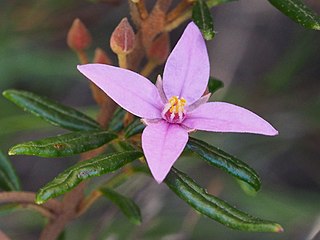
Boronia jucunda is a plant in the citrus family Rutaceae and is endemic to the far north-west of Australia. It is an erect shrub with many branches, pinnate leaves and white, four-petalled flowers. It is only known from a small area in the Kimberley region in Western Australia and in a national park in the Northern Territory.

Boronia latipinna, commonly known as the Grampians boronia, is a plant in the citrus family Rutaceae and is endemic to the Grampians in Victoria. It is an erect, woody shrub with pinnate leaves and pink or white, four petalled flowers.

Cyanothamnus occidentalis, commonly known as the rock boronia, is a plant in the citrus family Rutaceae and is endemic to eastern Australia. It is an erect, woody shrub with pinnate or bipinnate leaves and groups of up to three white to pale pink, pink four-petalled flowers arranged in leaf axils.

Boronia pilosa, commonly known as the hairy boronia, is a plant in the citrus family Rutaceae and is endemic to south-eastern Australia. It is an erect, woody shrub with hairy branches, pinnate, sometimes hairy leaves and groups of up to ten white to pink, four petalled flowers.

Boronia angustisepala is a plant in the citrus family Rutaceae and is endemic to New South Wales, Australia. It is an erect shrub with many branches, pinnate leaves with up to eleven leaflets, and bright pink, four-petalled flowers.
Boronia barrettiorum is a plant in the citrus family Rutaceae and is only known from two populations growing north of the Prince Regent River in the Kimberley Australia region of Western Australia. It is an erect, open shrub with hairy branches and leaves, simple or trifoliate leaves and white, four-petalled flowers.
Boronia cremnophila, commonly known as the Kimberley cliff boronia, is a plant in the citrus family, Rutaceae and is endemic to a small area in the Kimberley region of Western Australia. It is an erect or spreading shrub with both simple, and trifoliate leaves, and white sepals and petals, the sepals larger than the petals.

Boronia decumbens is a plant in the citrus family Rutaceae and is endemic to northern parts of the Northern Territory. It is a low, spreading shrub with pinnate leaves and white to pink flowers with the four sepals larger than the four petals.

Boronia elisabethiae is a plant in the citrus family Rutaceae and is endemic to Tasmania. It is a semi-erect or weakly spreading, woody shrub with pinnate leaves and white to pink, four-petalled flowers.

Boronia filicifolia is a plant in the citrus family, Rutaceae and is endemic to the far north-west of Australia. It is an erect or sprawling shrub with many branches, pinnate leaves with up to 55 leaflets and white to pink flowers with the sepals a similar length to the petals.

Boronia galbraithiae, commonly known as the aniseed boronia or Galbraith's boronia, is a plant in the citrus family Rutaceae and is endemic to a small area in Victoria. It is an erect, woody, fennel-scented, hairless shrub with pinnate leaves and white to deep pink, four-petalled flowers arranged in groups in the leaf axils.
Boronia interrex, commonly known as the Regent River boronia, is a plant in the citrus family, Rutaceae and is endemic to a small area in the Kimberley region of Western Australia. It is an erect, sometimes low-lying shrub with pinnate leaves, cream-coloured to pale pink sepals and pink petals, the sepals longer and wider than the petals.

Boronia kalumburuensis is a plant in the citrus family Rutaceae and is endemic to the Kalumburu area of Western Australia. It is an erect or sprawling shrub with many branches, pinnate leaves and white to pink four-petalled flowers with the sepals longer and wider than the petals.
Boronia minutipinna is a plant in the citrus family Rutaceae and is endemic to a small area in the Kimberley region of Western Australia. It is an erect shrub with many branches, hairy stems and leaves, pinnate leaves and white to pink, four-petalled flowers with the sepals longer and wider than the petals.
Cyanothamnus montimulliganensis is a plant in the citrus family Rutaceae and is endemic to a single mountain in Queensland. It is an erect, woody shrub with pinnate or bipinnate leaves and white, four-petalled flowers usually arranged singly in leaf axils.

Boronia pauciflora is a plant in the citrus family Rutaceae and is endemic to the Kimberley region of Western Australia. It is an erect shrub usually with simple leaves and white to pink, four-petalled flowers.
Boronia rozefeldsii, commonly known as Schouten Island boronia, is a species of plant in the citrus family Rutaceae and is endemic to a small Tasmanian island. It is an erect, woody shrub with pinnate leaves and pink, four-petalled flowers. It is similar to B. pilosa which grows on the same island, but has larger petals and fewer hairs on the leaflets.
Boronia thedae, commonly known as the Theda boronia, is a plant in the citrus family, Rutaceae and is endemic to a small area in the Kimberley region of Western Australia. It is an erect shrub when young, later a prostrate shrub with many branches, pinnate leaves, four white to cream-coloured or pale pink sepals and four similarly coloured petals, the sepals longer and wider than the petals.

Boronia wilsonii is an erect shrub that is endemic to northern Australia. Its branches, leaves and backs of the flowers are densely covered with woolly hairs. The petals are white to pink or burgundy-coloured.
Cyanothamnus yarrowmerensis is a species of erect, woody shrub that is endemic to Queensland. It has pinnate or bipinnate leaves and groups of up to seven flowers with white petals in leaf axils.












